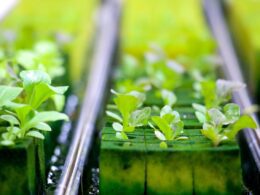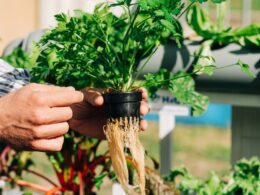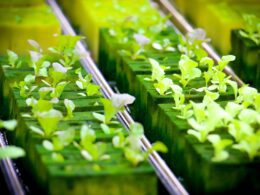Are your hydroponic roots turning brown? This can be a cause for concern for any hydroponic enthusiast. Brown roots can be a sign of various issues, including nutrient deficiencies, root rot, or excess light exposure.
It is important to understand the causes of brown roots and how to prevent and treat them to ensure the health and success of your hydroponic system.
In this article, we will explore the common causes of brown roots in hydroponic systems and provide you with prevention methods and treatment options to keep your plants thriving. We will also discuss the importance of regular maintenance and monitoring to catch any issues early on.
By the end of this article, you will have a better understanding of why your hydroponic roots may be turning brown and what you can do to fix the problem.
Understand the Causes of Brown Roots
You might be feeling frustrated and confused as to why your plants’ roots are turning a murky color, but understanding the reasons behind this phenomenon is crucial in maintaining a healthy hydroponic system.
Brown roots can be caused by a variety of factors, including a lack of oxygen, nutrient imbalances, and root diseases. All of these issues can have a negative impact on plant growth and reduce your overall yield.
One of the most common causes of brown roots in hydroponic systems is a lack of oxygen. When the roots aren’t getting enough oxygen, they’ll start to turn brown and may even begin to rot. To remedy this issue, it’s important to make sure that your system has good aeration and that your water is properly oxygenated. You can also consider adding an air stone or increasing the water flow to provide more oxygen to the roots.
Another potential cause of brown roots is nutrient imbalances. If your plants aren’t getting the right nutrients, their roots may start to turn brown and become weak. It’s important to regularly check your nutrient levels and adjust them as needed. Additionally, make sure that your pH levels are balanced and that you’re providing your plants with the right amount of light and water.
By making these adjustments, you can help prevent brown roots and keep your plants healthy and thriving.
Prevention Methods
If you want to prevent brown roots in your hydroponic system, there are a few things you can do. First, make sure to monitor water levels regularly and adjust as needed.
Second, provide adequate oxygen to your plants by ensuring proper aeration and circulation.
Third, maintain nutrient balance by regularly testing and adjusting your nutrient solution.
Finally, practice proper sanitation by regularly cleaning your system and tools to prevent the growth of harmful bacteria and fungi.
By following these simple steps, you can help ensure healthy and vibrant roots in your hydroponic system.
Monitor Water Levels
Keep an eye on how much water you’re giving your plants if you want them to thrive! One of the main reasons why hydroponic roots turn brown is due to over-watering. Make sure you’re not giving your plants too much water, as this can lead to the roots becoming waterlogged and unable to absorb nutrients properly.
Monitoring your water levels is crucial to maintaining healthy hydroponic roots. Check your water quality and pH levels regularly to ensure that they’re within the optimal range for your plant species. A pH level that’s too high or too low can make it difficult for your plants to absorb nutrients, leading to brown roots and stunted growth.
Additionally, make sure that your water is well-oxygenated, as oxygen is essential for healthy root development. By keeping an eye on your water levels and making adjustments as needed, you can prevent brown roots and promote healthy growth for your hydroponic plants.
Provide Adequate Oxygen
Make sure to provide enough oxygen for your plants to thrive in hydroponic systems, as it’s crucial for their healthy growth and development. Without proper oxygenation strategies, your plants may experience stress, stunted growth, and even death. Here are some tips to ensure your plants are receiving enough oxygen in your hydroponic system:
-
Use an air pump and air stones to increase oxygen levels in the water.
-
Keep the water temperature below 75°F, as warmer water holds less oxygen.
-
Monitor the water level and add fresh water regularly to maintain oxygen levels.
-
Avoid overcrowding your plants, as this can lead to reduced oxygen levels.
-
Consider using a water chiller to keep the water temperature consistent and stable.
Remember, plants rely on oxygen to produce energy through respiration. Without enough oxygen, their ability to absorb nutrients and grow may be compromised. By providing adequate oxygenation strategies, you can ensure your plants are thriving in your hydroponic system and responding positively to their environment.
Incorporating these tips can help you avoid the problem of brown roots in your hydroponic system. With proper oxygenation, your plants will be able to grow and develop strong, healthy roots that will support their overall growth and development.
Keep an eye on your plant’s response to these strategies, and make adjustments as needed to ensure your plants are receiving the best care possible.
Maintain Nutrient Balance
You need to maintain a balanced nutrient solution to ensure your plants are receiving the essential elements they need for optimal growth, leading to lush, vibrant greenery that will leave you feeling proud and accomplished. Nutrient deficiencies can cause your hydroponic roots to turn brown, stunting plant growth and even leading to the death of your plants. Therefore, it’s important to monitor your plants regularly and adjust your nutrient solution as needed.
One factor to consider when maintaining a balanced nutrient solution is pH levels. pH levels can affect how well your plants absorb nutrients, so it’s crucial to keep the pH of your solution within the appropriate range. In general, most plants prefer a pH between 5.5 and 6.5.
If your pH is too high or too low, this can cause nutrient imbalances and lead to brown roots. Therefore, it’s important to test your solution regularly and adjust the pH level as needed to ensure your plants are getting the nutrients they need.
Proper Sanitation Practices
Maintaining a clean and sanitary environment for your hydroponic plants is crucial to ensure that they grow healthy and free from harmful bacteria. Proper sanitation practices include regular equipment maintenance and the use of disinfectant solutions.
Make sure to clean and sanitize all equipment, including grow trays, pumps, and tubing, before and after use. This will eliminate any lingering pathogens that may be present and prevent them from spreading to your plants.
To disinfect your equipment, you can use a variety of solutions, such as bleach or hydrogen peroxide. Dilute the solution according to the manufacturer’s instructions and apply it to your equipment using a spray bottle or a cloth.
Allow the solution to sit for a few minutes before rinsing it off with clean water. By following these simple sanitation practices, you can ensure that your hydroponic roots stay healthy and free from disease.
Are Brown Roots the Cause of My Hydroponic Strawberries Turning Brown?
Wondering why your hydroponic strawberries are turning brown? Brown roots might not be the culprit. Hydroponic strawberry browning causes and solutions can vary. Factors such as nutrient imbalances, improper pH levels, nutrient deficiencies, or fungal diseases can induce browning. Maintaining correct nutrient levels, ensuring proper pH balance, and practicing good hygiene can help tackle this issue.
Treatment Options
To effectively address brown roots in your hydroponic system, it’s recommended that you consider various treatment options. One option is to flush your system with fresh, clean water to remove excess nutrients or salts causing discoloration. Another option is to add a nutrient solution specifically formulated for root health, as nutrient deficiencies can also lead to brown roots.
You may also want to consider using beneficial bacteria or fungi in your hydroponic system. These microorganisms can help break down organic matter causing problems and promote healthy root growth. Additionally, try using a root stimulator or booster to encourage new growth and restore plant vitality.
Remember, prevention is key to maintaining a healthy hydroponic system. Regularly clean and sanitize equipment, and monitor nutrient levels to ensure proper nutrition. By taking these steps, you can prevent brown roots and other issues from arising in your hydroponic garden.
Regular Maintenance and Monitoring
Make sure to regularly check and clean your equipment, as well as monitor nutrient levels to keep your hydroponic garden healthy and thriving. One important aspect of regular maintenance is pH testing. Hydroponic systems are sensitive to pH levels, so it’s important to test and adjust the pH of your nutrient solution regularly.
A pH level that’s too high or too low can cause nutrient deficiencies and lead to brown roots. In addition to pH testing, monitoring nutrient levels is also crucial for maintaining healthy roots. Nutrient deficiencies can cause the roots to turn brown and can stunt plant growth.
Make sure to follow the recommended nutrient schedule for your specific hydroponic system, and adjust as necessary based on the growth stage of your plants. It’s also important to regularly clean your hydroponic system to prevent the buildup of algae and other harmful bacteria that can cause root rot.
By regularly maintaining and monitoring your hydroponic system, you can prevent brown roots and ensure that your plants are receiving the necessary nutrients to thrive. Keep in mind that hydroponic gardening requires attention to detail and consistent care, but the rewards of a healthy and bountiful harvest are well worth the effort.
So take the time to test your pH levels, monitor nutrient levels, and clean your equipment, and enjoy the benefits of a thriving hydroponic garden.
Conclusion and Final Thoughts
Now that you know the importance of regular maintenance and monitoring for your hydroponic system, it’s time to focus on maintaining your root health and nutrient absorption. Healthy roots are essential for the growth and development of your plants. Brown roots can indicate a problem with your hydroponic system, and it’s important to address it promptly.
Here are three things you can do to maintain root health and nutrient absorption in your hydroponic system:
- Check your pH levels regularly to ensure they’re within the recommended range for your plants.
- Keep your water temperature consistent, between 65-75 degrees Fahrenheit, to avoid stressing your roots.
- Use a high-quality nutrient solution that provides all the necessary nutrients for your plants to thrive.
Compared to soil-grown plants, hydroponic root health is even more critical because the roots are entirely submerged in water. Hydroponic roots are also more susceptible to diseases and nutrient deficiencies, making it essential to maintain optimal root health.
By monitoring your pH levels, water temperature, and nutrient solution, you can ensure that your plants are getting the nutrients they need to grow healthy and strong. Remember, healthy roots are the foundation of a healthy hydroponic system.
By maintaining proper root health and nutrient absorption, you can ensure that your plants are thriving and producing high yields. Keep up with your regular maintenance and monitoring, and don’t hesitate to address any issues with your hydroponic system to maintain optimal root health.
Frequently Asked Questions
How long does it take for hydroponic roots to turn brown?
If you’re growing plants using hydroponics, it’s important to take care of your root health. Prevention methods like maintaining proper pH levels, providing enough oxygen, and keeping your nutrient solution clean can help keep your roots healthy.
It’s also important to monitor your root health regularly, as well as keeping an eye out for signs of discoloration or damage. Hydroponic roots can turn brown for a variety of reasons, including nutrient imbalances, poor water quality, or disease.
However, with proper care and attention, you can help ensure that your hydroponic roots stay healthy and vibrant.
Can brown roots affect the health and growth of the plants?
Ensuring root health management in your hydroponic system is crucial for the overall growth and health of your plants. Brown roots can be an indicator of nutrient deficiencies, which can hinder plant growth and lead to stunted development.
It’s important to carefully diagnose any nutrient deficiencies and address them promptly to prevent further damage to your plants. Regular monitoring and maintenance of your hydroponic system can help prevent these issues and promote healthy root growth.
By taking proactive measures to maintain root health, you can ensure the success and longevity of your hydroponic garden.
Are there any natural remedies to prevent or treat brown roots in hydroponics?
If you’re looking for natural remedies to prevent or treat brown roots in hydroponics, there are a few options to consider. Organic solutions, such as using compost tea or worm castings, can help improve the health of your plants and prevent root rot. Non-organic solutions, such as hydrogen peroxide or bleach, can also be used, but it’s important to dilute them properly and use them sparingly as they can harm your plants if not used correctly.
Ultimately, the choice between natural vs. chemical remedies and organic vs. non-organic solutions is up to you and your personal preferences. However, it’s important to always prioritize the safety and health of your plants when making decisions.
Can the type of hydroponic system or nutrient solution affect the color of the roots?
When it comes to hydroponics, the type of system you’re using and the composition of your nutrient solution can definitely affect the color of your roots. Different hydroponic systems, like deep water culture or aeroponics, have their own unique requirements for oxygen and nutrient delivery, which can impact root health.
Similarly, the nutrient solution you use should be carefully balanced to ensure your plants are getting the right amounts of all the essential elements they need to thrive. If your roots are turning brown, it could be a sign that something is off with your system or solution, so it’s important to pay close attention to these factors to keep your plants healthy and strong.
Is it safe to consume plants with brown roots in hydroponics?
If you’re growing plants hydroponically, it’s important to consider food safety when it comes to the health of your roots. Brown roots can sometimes be a sign of nutrient deficiencies in hydroponics, but this isn’t always cause for concern.
While it’s generally safe to consume plants with brown roots in hydroponics, it’s still important to take care of your plants and ensure they’re getting the nutrients they need to thrive.
Regularly monitoring the health of your hydroponic roots and adjusting your nutrient solution as needed can help keep your plants healthy and safe to eat.
Conclusion
So, there you have it! Brown roots in your hydroponic system can be a sign of various issues, such as nutrient imbalance, overwatering, root rot, or even algae growth.
However, with a little bit of knowledge and effort, you can easily prevent, treat, and maintain healthy roots for your plants. Remember to regularly check your water quality, pH levels, and nutrient solutions to ensure they’re within the correct range. Use proper sterilization techniques, such as changing the water and cleaning the system, to prevent the growth of harmful microorganisms.
Don’t forget to keep an eye on your plants’ growth and overall health, as this can also indicate any root problems. Overall, keeping your hydroponic roots healthy and free of brown discoloration is crucial for the success of your plants. With the right care and attention, you can enjoy a thriving hydroponic garden all year round!









